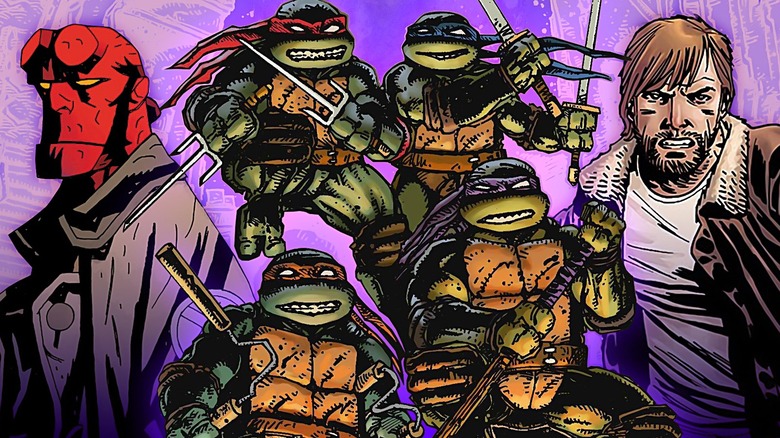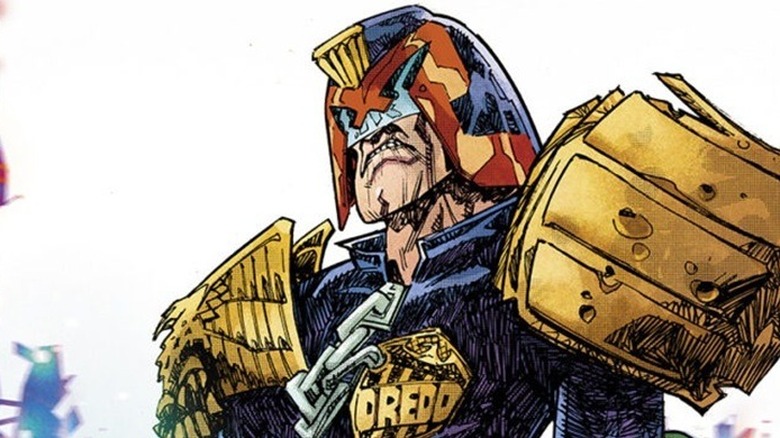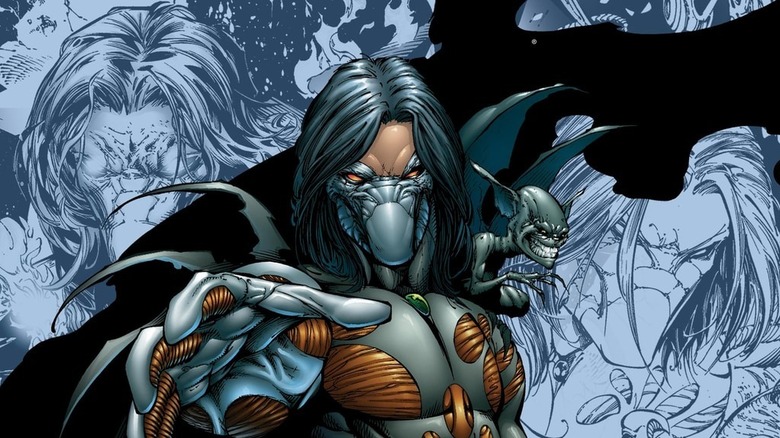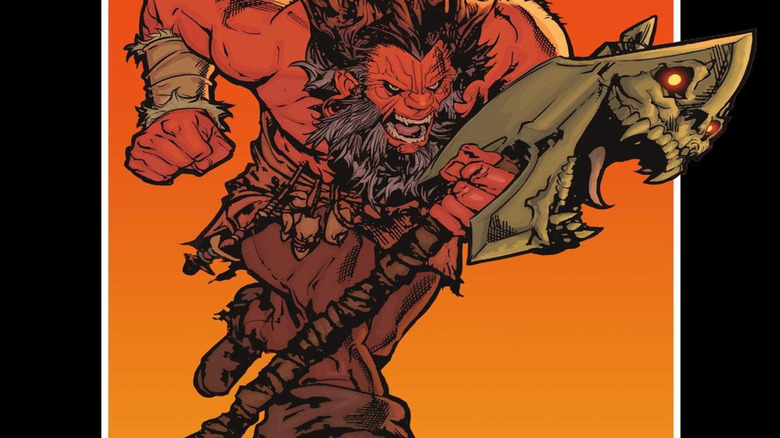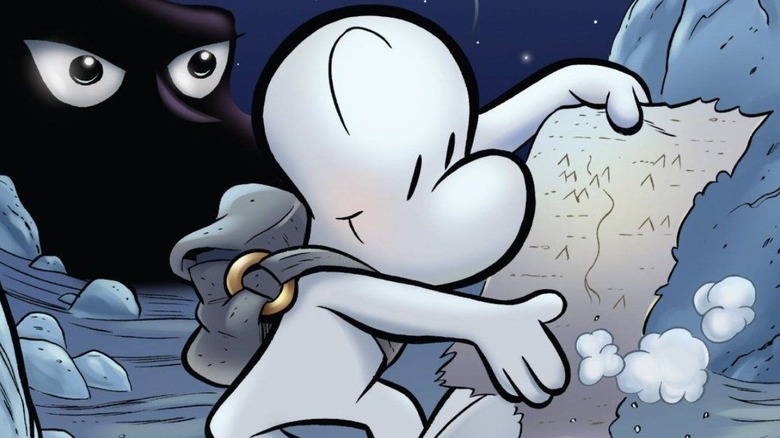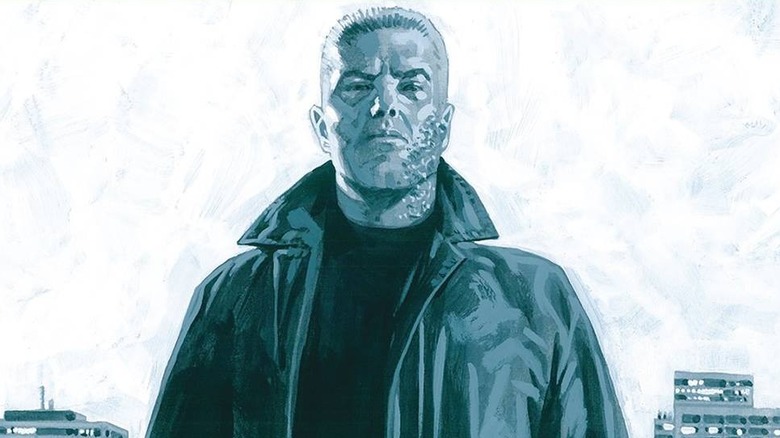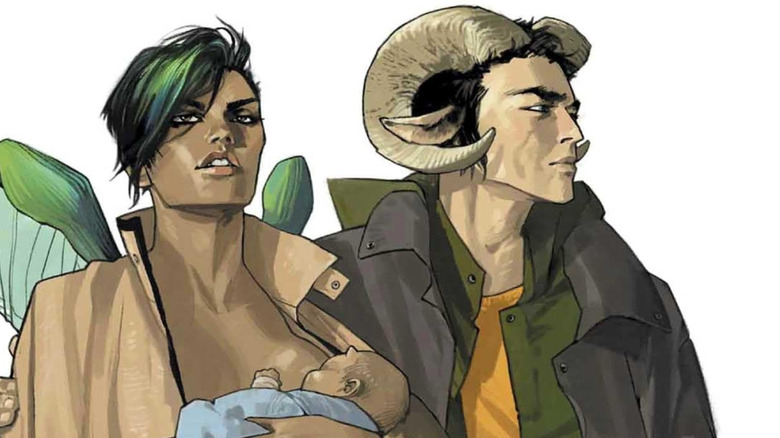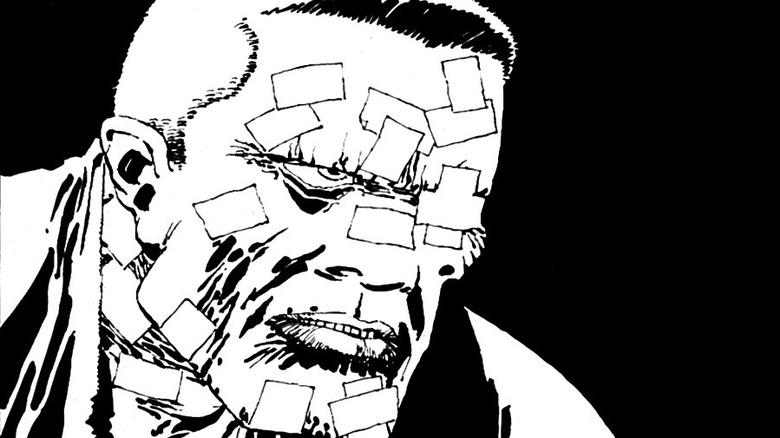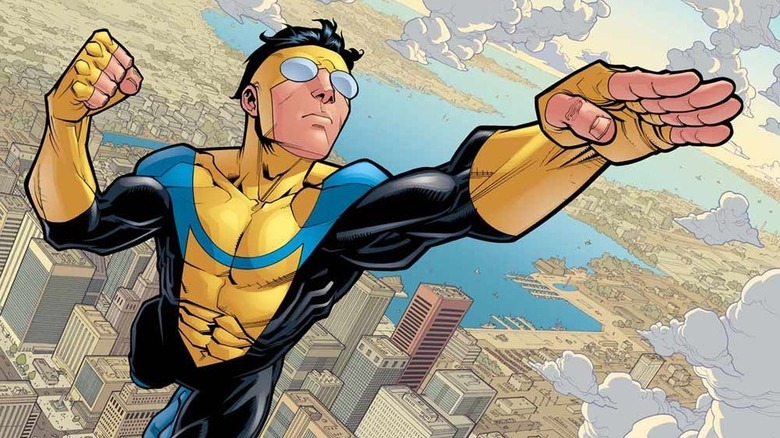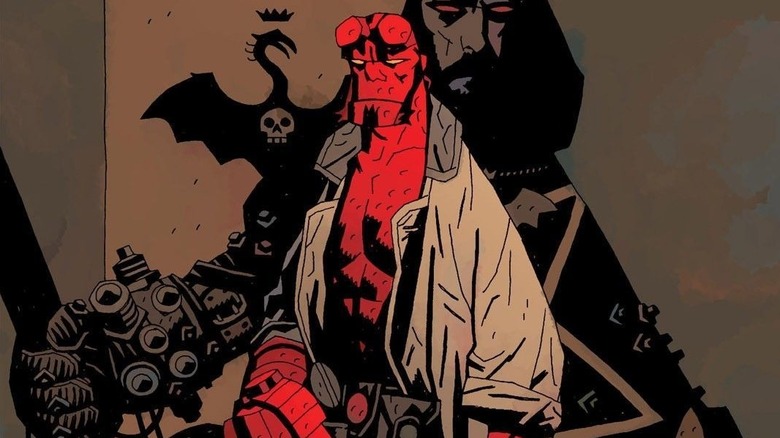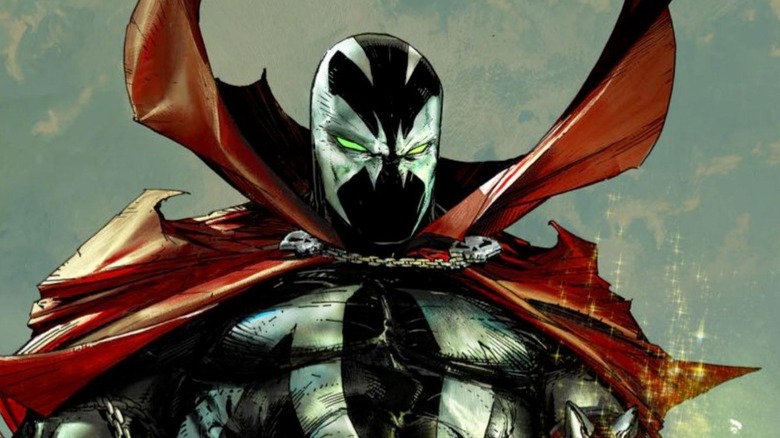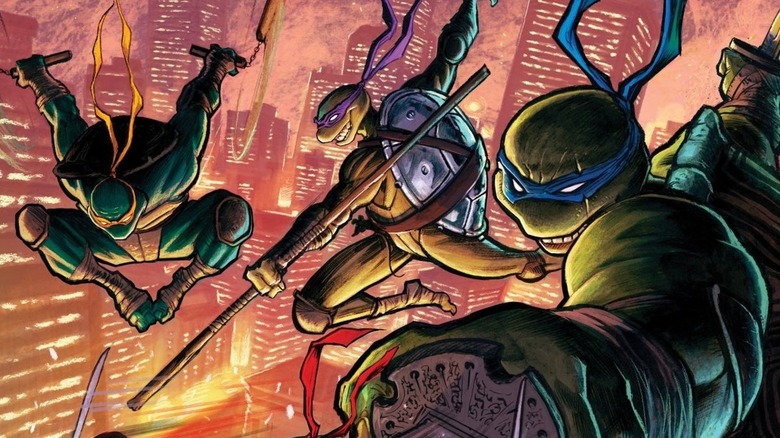12 Best Comic Books Outside Of Marvel & DC, Ranked
We have already covered the greatest DC Comics ever, as well as various countdowns of the best of the best from Marvel, but let's be real for a second: the indie market has its fair share of seminal comic books too. For many readers, that's where the real magic happens, as creatives play outside of the assigned sandboxes and free from corporate oversight and meddling. The only limit here is where their imagination takes them.
But how do you pick the best comic books outside of Marvel and DC? It isn't an easy task and requires a few considerations. Ultimately, it comes down to being a mix of universally popular series and personal preference, but also analyzing the books' wider influence on pop culture. Did they lead to on-screen adaptations or video games? Did they force the industry to up its game? Those types of questions. In addition to this, there was an avoidance of purely graphic novel releases — that's for a separate feature for some other time.
With that said, let's get down to business and uncover the best indie comics. A number of impressive titles, such as Brian K. Vaughan and Cliff Chiang's "Paper Girls" and Scott Snyder and Jock's "Wytches," narrowly missed out on this list, but you should read them too. You know what? Reading comics is sage advice in general, so do it.
12. 2000 AD
Since 1977, the weekly comic anthology magazine "2000 AD" has produced the best in British sci-fi. Over the decades, the magazine has been responsible for becoming the launching pad for major talents, such as Alan Moore and Alan Grant, while also inviting other established writers and artists, such as Grant Morrison and Steve Dillon, to contribute to its legacy.
However, "2000 AD" is best known for being the birthplace of "Judge Dredd," which was created by John Wagner and Carlos Ezquerra. Set in a dystopian reality and serving as a slick satire of authoritarianism, the series exploded out of the pages, finding itself turned into board games, video games, and even two live-action movies. Starring Sylvester Stallone as the lawman, 1995's "Judge Dredd" is perhaps the stupidest science fiction film to predict our terrifying present, while 2012's "Dredd," which stars Karl Urban as the eponymous character, is one of the most underrated comic book movies of all time.
In a way, "Dredd" embodies the spirit of "2000 AD": wildly underestimated and deserving of far more love from the audience around the globe. Also, it isn't only "Judge Dredd" that makes this magazine a worthwhile read, since it has published other phenomenal series — or what it refers to as "progs" — such as "Rogue Trooper" and "Nemesis the Warlock."
11. The Darkness
Set in the same universe as "Witchblade," and closely tied to the story of Sara Pezzini's otherworldly gauntlet, "The Darkness" edges out its sister series here, because of how unique its stories are in merging both the mobster and superhero genres into one addictive package. Created by Marc Silvestri, Garth Ennis, and David Wohl for Top Cow Productions, "The Darkness" follows the story of hitman Jackie Estacado who carries the entity known as the Darkness inside him. This force grants Jackie supernatural abilities and the dominion over demons known as Darklings, while he attempts to reconcile whether he'll use his powers for good or his own gain.
Sure, "The Darkness" contains the edgy storytelling and artwork synonymous with the '90s, but the series takes the reader on wild and unexpected journeys throughout its initial run and reboot. It also broke out of the comic book medium, receiving two outstanding first-person shooter video games that introduced an entirely new audience to the lore. It's a rotten shame that no one in Hollywood has turned "The Darkness" into a movie yet, because it would be the perfect merger of "John Wick" and "Spawn" with its boundless blend of guns, gore, and the grotesque.
10. Barbaric
Stop if you have heard this before: Owen the Barbarian is doomed to do only good for the rest of his miserable existence. His main pal on his travels is his talking weapon, Axe, who believes the action is the juice and loves more than a few pints after a day of grinding. Together, they embark on bloody adventures that find them in all kinds of peril.
Never heard of it? That's because Vault Comics' "Barbaric" is one of the most original comic books outside of Marvel and DC. It's unlike anything else you have ever read — guaranteed. Created by Michael Moreci, Nathan C. Gooden, Addison Duke, and Jim Campbell, "Barbaric" is the newest series on this list, since it was only released in 2021. However, don't let its youth deceive you, because it's an instant classic that never gets old, dripping with more action and humor than the blood on Axe. And there's a lot of blood here!
"Barbaric" has also caught the attention of Hollywood. It's set to be Michael Bay's first Netflix show and will star Patrick Stewart as the demonic talking Axe. Praise the movie gods for this outstanding casting choice!
9. Bone
Jeff Smith's "Bone" was once described by Time as having the style of a Disney movie but the storytelling breadth of "The Lord of the Rings," and that's probably the most accurate description about the series that exists. Started in 1991, "Bones" ran for 55 issues, completing its arc in 2004. Even though the release schedule wasn't consistent, it was one of those rare books that people looked forward to reading and never forgot about the plot from issue to issue, since it was easy to follow and largely unforgettable.
It's a reminder of a simpler time in comics, reminiscent of "Asterix" where the humor and adventure hold hands tightly for an all-encompassing story that often defies genre classification and convention. In the case of "Bone," it's all about the escapades of the Bone cousins, Fone, Phoney, and Smiley. Each of them possesses a distinct personality that's different from the other, but they are forced to work together as they traverse a fantasy world. The comic book also features such a warm and inviting cartoon style that's appealing to both young and old. Sadly, Netflix fumbled a "Bone" adaptation to the point that it had Smith airing his frustrations via a comic strip.
8. Criminal
Technically, "Criminal" might be cheating in terms of being a comic book outside of Marvel and DC, since it was originally published under the Marvel imprint Icon Comics. However, the title moved over to Image Comics before Icon went defunct, while the previous issues were collected and re-released via Image, so it's completely indie now. Also, there are no Marvel characters here, so this is an entirely original piece of work with no ties to radioactive spiders or Infinity Gauntlets.
The selling point for "Criminal" is the pairing of creatives Ed Brubaker and Sean Phillips. Anyone who has followed their careers knows they have become synonymous with the crime genre in the medium, and "Criminal" is just them flexing how far ahead of everyone else they are. While the stories take place in the same universe, each arc tends to revolve around different characters but still intersects with what came before it.
Everything in this series is hard boiled, morally ambiguous, and gritty, making Gotham City look like Ibiza in comparison and proving without a shadow of a doubt that no one pumps out crime comics quite like Brubaker and Phillips. "Criminal" is also receiving a TV adaptation at Prime Video, with Charlie Hunnam playing Leo from the "Coward" story arc. It's a pitch-perfect casting, really, especially considering Hunnam's "Sons of Anarchy" pedigree.
7. Saga
Created by "Lost" writer Brian K. Vaughan and "Archie" artist Fiona Staples, "Saga" is exactly that: a saga. It tells the epic tale of Alana and Marko, who come from two alien races at war. It doesn't matter to them, because the heart wants what the heart wants, so love wins in the end. However, matters take a dramatic turn when they have a daughter, Hazel, and need to escape from the clutches of galactic forces.
"Saga" is a modern-day "Romeo and Juliet" set in space, with the grandiose worldbuilding of "Star Wars" and the political shrewdness of "Game of Thrones" infused into its veins. What's most impressive about the series is how layered and rich the storytelling is, exploring a variety of different and pertinent themes. It shouldn't be too surprising, though, since Vaughan has had the tale rolling around in his head since he was a teenager, so he's had some time to think about it properly.
Impressively, neither Vaughan nor Staples want to see "Saga" adapted into a movie or TV show, wanting it to remain only as a comic book series. "I wanted to do something that was way too expensive to be TV and too dirty and grown-up to be a four-quadrant blockbuster," Vaughan told The Hollywood Reporter.
6. Sin City
It's no secret that if it's dark and broody, it's Frank Miller's jam. In the '90s, Miller stepped out of Hell's Kitchen and Gotham City to create his own universe that takes place in Basin City — better known as Sin City. This place is the ultimate tribute to film noir where the line between hero and villain is blurred more than ever in an unforgiving city filled with lowlifes — and that's not even speaking about the bad guys. If you haven't figured it out yet, there are only sinners — not saints — in "Sin City."
Drawn in black and white, "Sin City" highlights Miller's strengths as a visual artist, as he utilizes minimalism to tell the maximum story. It's the comic book equivalent of "cinematic," for the lack of a better word, as the shadows and white spaces become their own essential characters here.
"Sin City" made its way onto the big screen in 2005, being turned into an anthology film helmed by Miller and Robert Rodriquez. Much like the comics, its unique visual style and narrative flavor turned it into something that caught the attention immediately, and it certainly helped to make the likes of "300" and "Watchmen" possible. The film received a sequel, "Sin City: A Dame to Kill For," in 2014, but this effort wasn't quite as successful as the original. Sadly, as former /Film writer Kayleigh Donaldson once wrote, few directors followed in "Sin City's" footsteps, and cinema is poorer because of it.
5. Invincible
Of course, everyone knows "Invincible" now, thanks to the stellar Prime Video animated series. It's one of the deepest and most layered superhero shows around, and that's because it embraces its source material rather than deviates from it. Created by Robert Kirkman, Cory Walker, and Ryan Ottley, "Invincible" debuted in 2003 via Image Comics. The comic stands out from the get-go, because of Walker and Ottley's homage to superhero art of the past, even though the "Invincible" story goes into much darker terrain than traditional cape and cowl capers.
That's the secret to "Invincible," right? It's all about the compelling story. Mark Grayson is like a combination of Spider-Man and Superman; a teenager blessed with an abundance of power, but he tries to balance it with a sense of responsibility and normality. He tries to learn under the tutelage of his father, Nolan, aka Omni-Man, but he soon finds himself at odds with his dad, resulting in him receiving one of the most brutal beatdowns in the history of comics. Yet, that's only the early stages of this tale that explores other characters, different worlds, and a wide range of themes. It's actually mind-blowing to think that Kirkman wrote "Invincible" and "The Walking Dead" at the same time for 15 years, and the quality never dropped in either series.
4. Hellboy
Mike Mignola's "Hellboy" is a mishmash of genre perfection. It's a superhero story by the way of fantasy, Lovecraftian horror, and historical fiction. In the series, it's not unusual to see the easily recognizable half-demon known as Hellboy square off against both supernatural monsters, such as the Baba Yaga, and human monsters, such as Nazis. Whichever way, no "Hellboy" story is ever boring, and he has a group of pals — like Abe Sapien, Johann Kraus, and Liz Sherman –- to help him on his missions.
"Hellboy" has also crossed the great divide between comics and other mediums, visiting the realm of video games, animated movies, and even live-action films. However, it must be stressed that the best "Hellboy" adaptations remain everything touched by Guillermo del Toro, while the rest is a little iffy in quality and appeal. Plus, it's next to impossible to imagine anyone else but Ron Perlman's voice when you think of Big Red. Perlman still wants to make "Hellboy 3" with del Toro and it should be allowed by the powers that be. Restore the del Toro-verse, you cowards!
3. Spawn
After leaving his mark on "The Amazing Spider-Man" and co-creating Venom, Todd McFarlane became a founding father of Image Comics where he released his creator-owned book "Spawn." The dark superhero story centers on merc Al Simmons who dies and gets sent to Hell for his crimes. There, he cuts a deal with the villainous Malebolgia and is reborn as a hellspawn. However, Al decides to use his new powers to help rather than hurt people.
While most comic book series go through reboots or periods where they disappear entirely, not "Spawn." In 2021, it established itself as the longest-running independent superhero title of all time. Also, it shows no signs of slowing down, as McFarlane continues to grow the "Spawn" Universe. Needless to say, it's carved out its own corner in the comic book landscape.
"Spawn" hasn't only stayed in the comics, though. The franchise spread to toys, video games, and a sensational HBO animated series that was ahead of its time. It also received a 1997 live-action film, starring Michael Jai White as the lead character, while McFarlane still holds grand ambitions of unleashing a "Spawn" cinematic universe.
2. The Walking Dead
Most people remember "The Walking Dead" from the TV show, and endless spin-offs, which started off phenomenally well, then degenerated into the characters doing too much "walking" and not enough "deading." Yet, like "Game of Thrones" was with its own source material, "The Walking Dead" comic book series is radically different to the show, with many fates being altered and storylines taking divergent turns. Also, the comic book storyline had a hard out, unlike the franchise that will go on until the ratings say it's enough.
Created by Robert Kirkman and Tony Moore, "The Walking Dead" caught the attention of comic book readers in the early 2000s because of its unpredictability factor. No character is safe in the series, as Kirkman proves to live by the adage of "kill your darlings" rather literally. Anyone and everyone is fair game here, and the comic book features even more brutal deaths than the ones from the show. The comic also holds the advantage that it doesn't need to fill time or space, so every issue is deliberate and furthers the story rather than meander to fulfil a 16-episode season.
While a lot of people gained zombie fatigue, partially due to the oversaturation of "The Walking Dead," it's recommended that everyone picks up the comic book series. It's simply a must-read for anyone who had even a passing interest in the show.
1. Teenage Mutant Ninja Turtles
What started out as a gag drawing between Kevin Eastman and Peter Laird in an effort to make each other laugh turned into one of the biggest franchises of the world. That's the true story of how "Teenage Mutant Ninja Turtles" was born, as no one could have expected a self-published tongue-in-cheek homage to Frank Miller's "Daredevil" that featured four anthropomorphic turtles named after Renaissance artists would be turned into countless video games, toys, movies, and animated series (including one show which I proudly declared the best cartoon of the 1980s).
While the Ninja Turtles franchise has evolved and taken many turns throughout the years, it's still alive and well at IDW Publishing, where its main series continues to be imaginative and refreshing for a franchise that's over 40 years old. Whether it be through the introduction of new characters, the evolution of old heads, or even seeing the roles reversed like Splinter taking over the Foot Clan and Shredder training the Turtles, "Teenage Mutant Ninja Turtles" remains the G.O.A.T. of comic book series. It's a reminder to creators that if you believe in something and pour your heart into it, it's infectious and other people feel it too. Now that's cowabunga, dudes!
